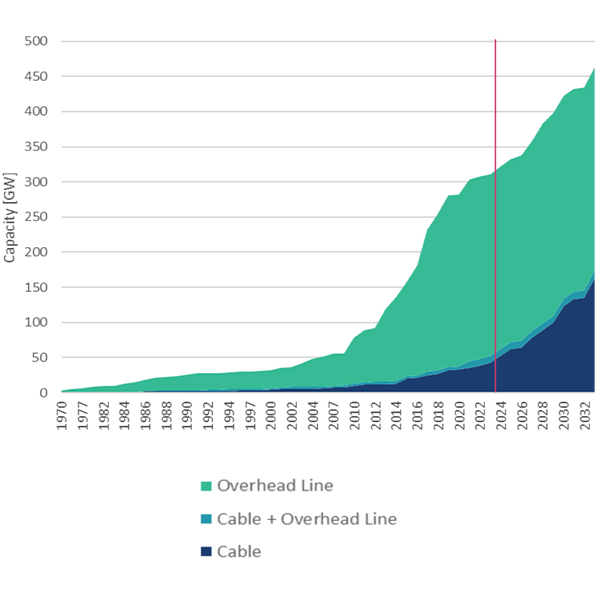
The U.S. is behind Europe in deploying HVDC transmission technology, according to a report released Tuesday by the Brattle Group and DNV for clean energy and transmission advocates.
“The Operational and Market Benefits of HVDC to System Operations” noted that 300 GW of HVDC capacity has been installed worldwide, with an additional 150 GW in the planning stages, most of it in the last decade. The report was sponsored by the American Council on Renewable Energy, Allete, Clean Grid Alliance, GridLab, Grid United and Pattern Energy Group.
“HVDC transmission has evolved dramatically over the last five to 10 years,” Brattle Group Principal and co-author Johannes Pfeifenberger said on a webinar hosted by ACORE. “HVDC offers higher capacity, longer distance [and] lower loss transmission on a smaller footprint, which really are key advantages.”
Connecting HVDC lines to the standard AC grid requires converters, and the newer voltage-sourced converters, which can be switched on and off by an external control signal — unlike the historically more common line-communicated converters that can only be turned on by an external signal — greatly enhance HVDC’s capabilities, Pfeifenberger said.
Europe has led the way in deploying modern HVDC technology with VSC converters recently, with about 50 GW of projects in operations and another 130 GW planned over the next 10 years. North America accounts for only 3% of the technology’s use and 30% of planned projects, most of which have been proposed by merchant developers.
“It’s pretty straightforward if you want to move power over long distance: DC is a much more efficient way to do that in terms of right-of-way cost and controllability,” said Grid United CEO Michael Skelly, whose firm has proposed a number of HVDC projects to connect the three interconnections.
In the mid-2000s, when Texas was considering the Competitive Renewable Energy Zone lines to bring wind power to market, they considered HVDC; Skelly said now there might be a “little bit of buyer’s remorse.” With how much growth ERCOT has seen in recent years, HVDC might make a comeback, he added.
The one domestic market the report highlighted as fully embracing HVDC technology is CAISO, with Pfeifenberger noting that the Trans Bay Cable in the San Francisco area is the first VSC HVDC project in the world.
“Because they were the first operator of a VSC-based HVDC line, the Trans Bay Cable, they really like the technology; they have optimized it into the market; they’re fully co-optimizing controllable transmission with generation in the day-ahead in real-time markets,” Pfeifenberger said. “They’re optimizing transmission across the entire West now. And they are developing a specific way to integrate merchant transmission lines into all this market optimization.”
The report is full of anecdotes about European countries starting to knit their grids together with new HVDC lines. Germany is linking up its wind-rich north and solar-rich south with major projects. Italy, which has HVDC subsea cables connecting Sicily and other islands, is now expanding its use similarly to its northern neighbor. Other examples abound around the continent.
HVDC works better than AC lines when it comes to burying transmission, said DNV Vice President and report co-author Cornelis Plet.
“Whenever power needs to be transported over more than 50 miles by underground cable or maybe 300 to 400 miles per overhead line, HVDC is the only technical, feasible option,” Plet said.
In addition to the ability to be out of sight, HVDC technology also requires a smaller footprint so it can help get transmission built in urban areas where new rights of way are very hard to procure, he added.
Another reason Europe has been building out so many lines is the growth of offshore wind, as DC lines can operate underwater. Now a major question on the continent is whether the HVDC lines should operate as single entities or be stitched together in an HVDC grid that overlays the AC system, Plet said.
One issue with the rapid growth in Europe is supply-chain concerns, as the manufacturing base — while currently sufficient — would be strained to try to meet an uptick in demand from North America as well, he added.
“The U.S. must build a similar project pipeline and, importantly, take advantage of the significant planning and operational experience that has already been gained with modern HVDC systems,” Plet said.
Another hurdle to getting HVDC or other major transmission needed to expand renewable power and address climate change is the current permitting process, said Rep. Sean Casten (D-Ill.), Congress’ chief FERC booster.
The lack of transmission is one of the two main problems with renewables, the other being that it “is too damn cheap,” Casten said on the webinar.
“You’ve generated this problematic resource that is super cheap: Whether it’s wind, whether it’s solar, you have effectively zero marginal cost,” Casten said. “And on the other end of that wire, you have a person or an entity — maybe it’s an RTO, maybe it’s a utility — who has an entire pile of assets that are dependent on earning $50, $60, $70/MWh, and you want to put $30 power into that market.”
That gives the entities who would receive that cheaper power a clear economic disincentive to do so, he added. The politics of defending high prices are not good, so opponents come up with spurious arguments like transmission causes “eagle cancer,” Casten quipped.
Casten and Rep. Mike Levin (D-Calif.) are working on a bill that seeks to be the Democrats’ opening position on transmission permitting. The two are trying to make sure the industry’s profit motive is aligned with transmission expansion to bring renewables to market, get the right participants in the planning process and then smooth out the siting and permitting processes.
“Let’s not make it harder to permit a transmission line than it is to permit a natural gas pipeline, which it is as long as we have only one authority responsible for one of those,” Casten said.


